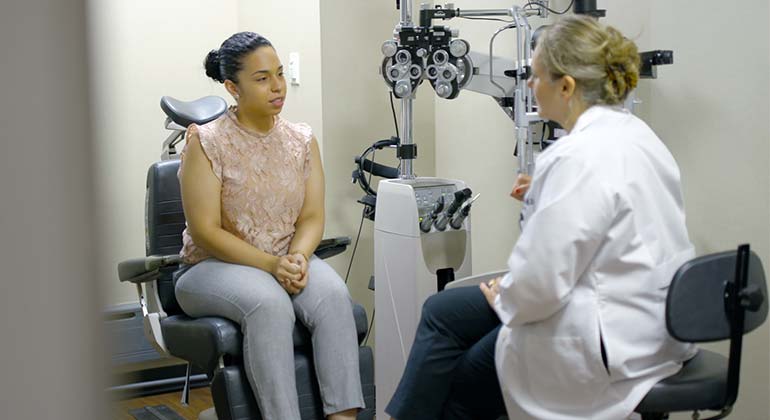The Benefits And Drawbacks of Various Refractive Surgical Treatments for Improved Eyecare

LASIK Surgery
LASIK surgical procedure is a generally executed refractive treatment that intends to remedy vision problems such as farsightedness, nearsightedness, and astigmatism. During the procedure, a thin flap is developed on the cornea, and a laser is made use of to improve the underlying tissue, fixing the refractive error.
One of the main advantages of LASIK surgery is the quick improvement in vision experienced by lots of patients. It is necessary for individuals thinking about LASIK surgical procedure to undergo a detailed assessment by an eye care specialist to identify if they are suitable candidates for the procedure.
PRK Procedure
The PRK treatment, likewise referred to as Photorefractive Keratectomy, is a kind of refractive surgery that intends to remedy vision problems similar to LASIK surgical procedure. Unlike LASIK, which entails developing a flap in the cornea, PRK deals with the surface area layer of the cornea. Throughout the PRK procedure, the outer layer of the cornea, called the epithelium, is eliminated to permit improving of the underlying corneal cells with an excimer laser. This reshaping helps to fix refractive errors such as nearsightedness, farsightedness, and astigmatism.
Among the advantages of PRK over LASIK is that it eliminates the risk of flap-related issues given that no flap is created during the surgery. This can be advantageous for individuals with slim corneas or those associated with call sporting activities where eye trauma is a possibility. The healing time for PRK is typically longer contrasted to LASIK, as the external layer of the cornea needs time to restore after the treatment. Despite the longer recuperation period, PRK can be an appropriate alternative for people seeking vision improvement surgical treatment.
SMILE Surgery
An innovative refractive surgical procedure technique acquiring appeal in the field of ophthalmology is SMILE Surgical procedure. Tiny Incision Lenticule Removal (SMILE) is a minimally intrusive procedure that fixes vision by reshaping the cornea using a femtosecond laser. Unlike conventional LASIK surgery, SMILE Surgical treatment involves producing a tiny cut in the cornea to remove a lenticule, which results in much less disruption to the corneal structure and potentially much faster healing times.
One of the primary benefits of SMILE Surgery is its capability to deal with myopia (nearsightedness) and astigmatism with high precision, bring about outstanding aesthetic end results for people. The minimally invasive nature of the procedure likewise lowers the risk of issues such as completely dry eye disorder, making it a beneficial choice for people looking for refractive surgical treatment.

LASEK Method
Having actually explored the benefits and factors to consider of SMILE Surgical procedure, one more notable refractive surgery strategy worth checking out is the LASEK Technique. LASEK, which stands for Laser-Assisted Subepithelial Keratectomy, go to website is a type of laser eye surgery that aims to fix refractive errors such as nearsightedness (nearsightedness), hyperopia (farsightedness), and astigmatism.
Unlike LASIK, LASEK does not entail creating a corneal flap. Rather, during a LASEK procedure, the specialist makes use of a watered down alcohol service to loosen the slim external layer of the cornea, called the epithelium. This layer is after that delicately moved aside to permit the laser to reshape the underlying corneal tissue. When the cornea has been improved to the preferred degree, the epithelial layer is rearranged.
One of the main benefits of LASEK is that it can be suitable for individuals with thin corneas that may not be great prospects for LASIK. Furthermore, LASEK generally causes minimal post-operative pain and a quicker recuperation time contrasted to PRK. Nonetheless, the aesthetic recovery procedure with LASEK might be slightly longer than with LASIK.
Implantable Get In Touch With Lenses
Implantable Contact Lenses offer a lasting vision modification option for individuals seeking an option to traditional get in touch with lenses or glasses. These lenses, additionally called phakic intraocular lenses, are operatively inserted into the eye to correct refractive errors such as myopia (nearsightedness), hyperopia (farsightedness), and astigmatism. andalusia pediatrics. Unlike typical contact lenses that remain on the surface of the eye, implantable contact lenses function within the eye itself, giving clear vision without the need for everyday maintenance or removal
One of the essential advantages of implantable contact lenses is their permanence. As soon as placed, they can continue to be in the eye forever, using secure and consistent vision improvement. In addition, these lenses can be a superb option for people that are not excellent candidates for laser eye surgical treatment or who like a reversible vision improvement treatment.
Nonetheless, implantable get in touch with lenses do bring some dangers, including the capacity for cataracts or enhanced eye stress. It is critical for individuals considering this alternative to consult with an eye care professional to figure out if implantable contact lenses are the best selection for their particular needs and eye health and wellness.
Conclusion
To conclude, each type of refractive surgery has its own advantages and disadvantages. LASIK visit their website surgery is preferred for its quick healing time, while PRK treatment might appropriate for patients with slim corneas. SMILE surgical treatment provides very little pain during the procedure, but LASEK technique might have a longer recovery process. Implantable contact lenses give a choice for those who are not suitable prospects for traditional surgical treatments. People must seek advice from their eye treatment service provider to establish the most effective choice for their private demands.

Overall, SMILE Surgical treatment provides an encouraging alternative for individuals looking to improve their vision with refractive surgical procedure.